In the previous tutorial, the basics of audio filters were covered. As we learned, audio filters can be passive or active depending on the components used and whether or not they require a power supply.
In terms of frequency response, filters can also be classified as high, low, band and all-pass, as well as notch, T-notch, band rejection and equalizer filters. Now we are ready to design an audio crossover.
An audio crossover is an electronic circuit that divides the audio signal into two or more frequency bands. These frequency bands are then sent to the different audio drivers (such as tweeter, woofer, or mid-range speaker). It is). However, a single speaker is unable to cover the entire range of audible frequencies due to the limitations of its design. Therefore, different drivers (speakers) are needed to deliver different ranges of frequencies.
For example, tweeters are typically used for high-frequency audio signals, while woofers are used for lower-frequency signals . As the name suggests, midrange drivers are ideal for mid-range signals.
To divide an audio signal into different frequency bands, separate audio filters are used in a crossover. They are typically classified as a two-way or three-way intersection.
Bidirectional divides the audio signal into two frequency bands – a high-frequency band for a tweeter and a low-frequency band for a woofer – and is the most common crossover used in standard audio systems.
Triple divides the audio signal into three bands, which is less common but more efficient. It splits the audio signal into different frequencies to better match the tweeter, woofer, and midrange speakers .
In this tutorial, we will build a two-way crossover using active audio filters. The crossover will have a high-pass filter to provide high-frequency signals to one speaker and a low-pass filter to provide low-frequency signals to another speaker. Both circuits will use an operational amplifier (operational amplifier) .
The audio will be received through a Smartphone and output through two different speakers. The cutoff frequency for both filters will be 500 Hz.
To test the crossover, we will check the frequency response curve of the audio filters. This curve will be drawn by plotting the voltage levels of the audio signal against the frequencies. A function generator will also be used as an input source to demonstrate sine waves at different frequencies.
We will use some common terms associated with audio amplifiers or audio filters, such as gain, clipping effect, cutoff frequency, bandwidth, and quality factor. We covered some of them in the previous tutorial: Understanding filters .
Required components
Figure 1. List of components required for a two-way audio crossover
Block diagram
Figure 2. Block diagram of a two-way audio crossover
Circuit Connections
In a crossover circuit, the audio signal is divided between different frequency bands. Each band is amplified separately and the output is applied to the appropriate drive unit. Each frequency band has a separate knob to control the audio signal gain, as shown here:
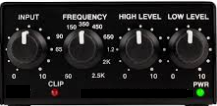
A typical two-way audio crossover.
This crossover circuit is designed by connecting these components…
Power Source – A dual power supply is used to power this circuit, using two 9V batteries. A DC source is required to bias the operational amplifiers used in both filter circuits. Batteries provide negative and positive supply voltages to the amplifiers.
Positive and negative supply voltages are supplied to the amplifiers used in both filters using the same batteries.
- To provide the negative supply voltage to the operational amplifiers, the cathode of a battery is connected to the negative supply pin of the amplifier and the anode of that battery is connected to ground.
- To provide the positive supply voltage to the op-amp, the anode of the other battery is connected to the positive supply pin of the amplifier and the cathode of that battery is connected to ground.
The batteries will be connected to the respective operational amplifier as shown in this circuit diagram:
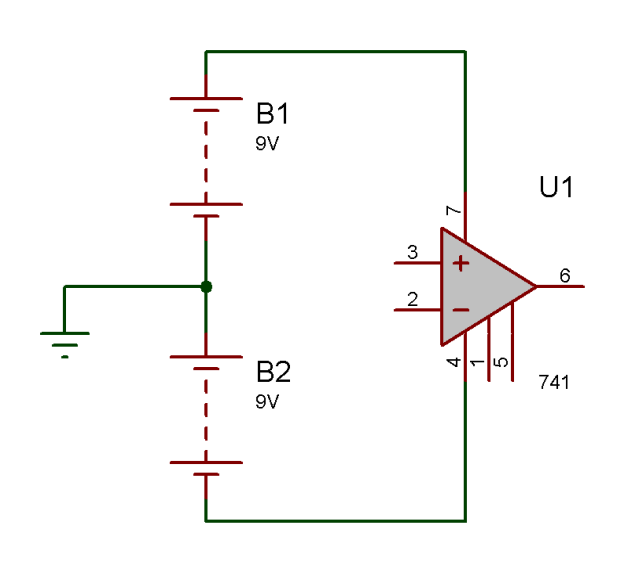
A circuit diagram of a dual power supply for active high-pass and low-pass filters.
Audio Source – The audio input for this project is provided by a Smartphone . To do this, we will need to plug a 3.5mm audio jack into the phone. The outlet must have three wires: one for ground, one for the left channel, and a third for the right channel. The wires that connect to the channels are used for the stereo systems.
In this system, the audio signal from both channels is transmitted with a phase difference of 180 degrees. The phase-shifted audio signals are combined to produce a noise-free audio signal, which is called a balanced audio system.
In our circuit, however, only one of the channels is used as an audio source. The ground wire of the connector is connected to common ground. Therefore, this audio system will be unbalanced and the audio source will be connected as a single or mono source channel.
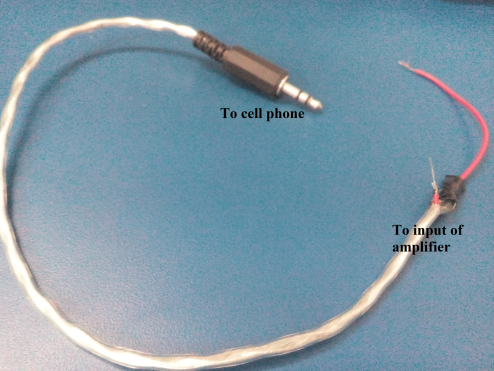
One 3.5mm audio jack.
High Pass Filter – An active first order high pass filter is connected in the circuit. By this filter, the audio input is passed through the non-inverting pin of the op amp through an RC network (which means it uses a resistor and a capacitor).
The audio signal passes through the capacitor. Its impedance is inversely proportional to frequency and capacitance — therefore, the lower the frequency, the higher the impedance and vice versa. The high frequency audio signal element will therefore have less impedance and will easily pass through the capacitor and into the non-inverting input of the amplifier. The low frequency element of the signal will contain a higher level of impedance. It is bypassed by the resistor connected to ground.
Capacitor impedance can be determined using this equation:
(Impedance), Xc= 1/ (2π*f*C)
T The high-pass filter is designed using a 100 nF capacitor (“C1” in the circuit diagram) and a 3.2 kilo-ohm resistor (“R2”). Using these values for the capacitor and resistor, the filter cutoff frequency can be calculated as follows:
FH= 1/ (2πR2C1)
FH= 1/ (2π*3.2k*100n)
FH= 500 Hz (approx.)
The RC network forms a passive high-pass filter. Through this network, the filtered audio signal – which now carries only high frequency signals – is passed to the operational amplifier non-inverting pin.
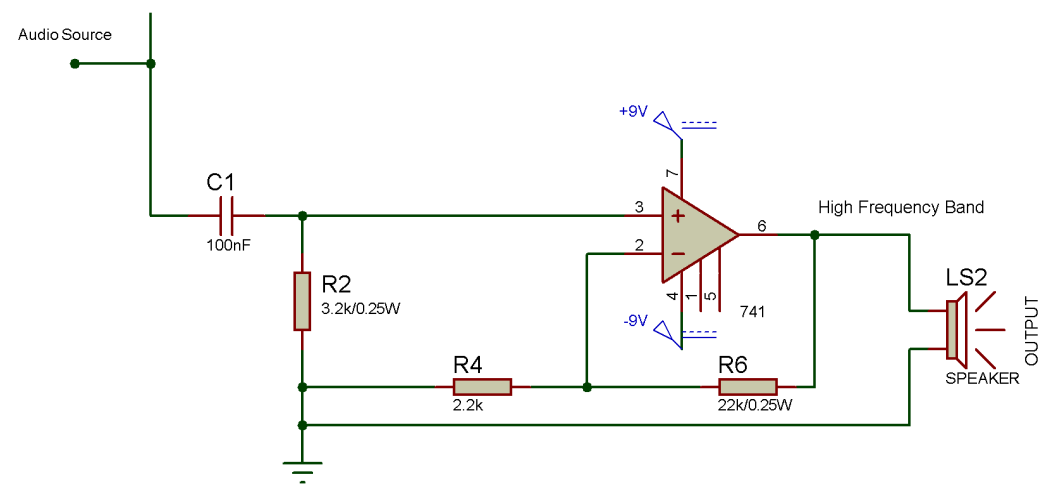
A circuit diagram of an LM741 operational amplifier in an active high-pass filter.
For this project, we are using operational amplifier IC LM741. The LM741 is a general purpose operational amplifier with a low input impedance ( in megaohms), compared to a FET operational amplifier, which has a high input impedance ( in gigaohms) .
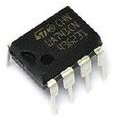
The LM741 IC
The output impedance of the 741 should ideally be zero, but is typically around 75 ohms. The maximum supply current of the 741 IC is about 2.8 mA, with a supply voltage of up to +/- 18V.
The IC has the following pin configurations:
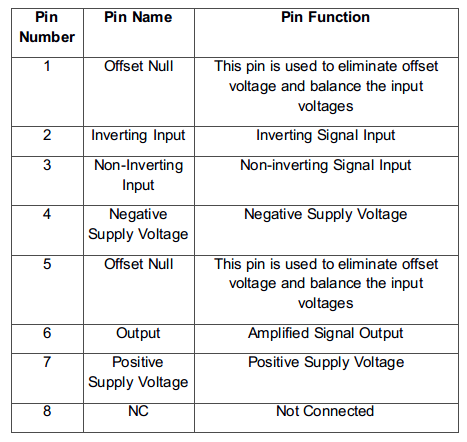
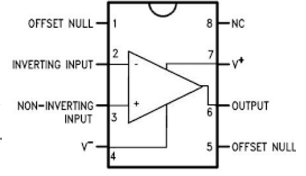
The IC has input and output overload protection and has zero latch when the common mode range is exceeded. The IC can receive a positive or negative supply voltage of up to 22 V and an input signal voltage (amplitude) of up to 15 V. Generally, a positive or negative voltage of at least 10 V must be supplied.
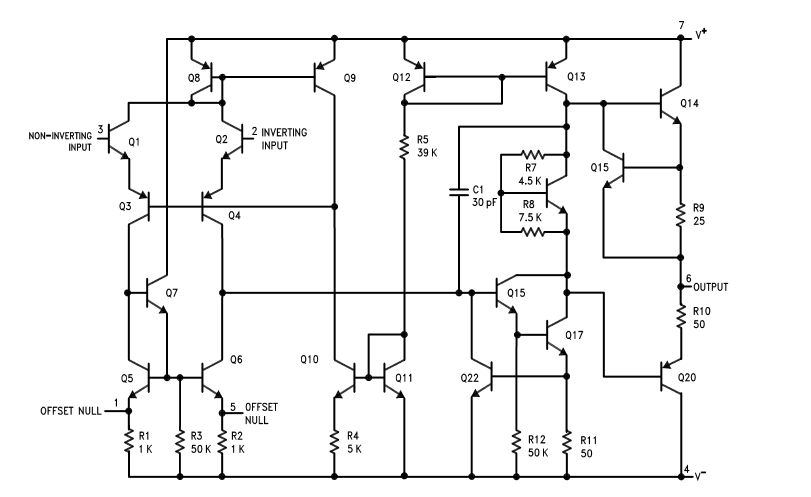
The internal circuit diagram of an operational amplifier IC LM741.
The LM741 can be configured as an open or closed loop amplifier and as an inverting or non-inverting amplifier.
In this circuit, IC LM741 was used as a non-inverting amplifier. T The input signal of the passive high-pass filter is connected to the non-inverting input pin of the IC (pin 3). A 22 kilo-ohm resistor (“R5” in the circuit diagram) is connected between pins 6 and 2 of the IC, providing negative feedback. The inverting pin (pin 2) is grounded through a 2.2 kilo-ohm resistor (“R3”) .
The amplifier gain is defined by these resistors and can be calculated as follows:
Gain = (R5/R3)
= 22/2.2 thousand ohms
= 10
As a result, the high frequency element of the audio signal is amplified 10 times compared to the input audio signal. The output of the op amp is taken from pin 6 of the IC, which is connected to one of the speaker wires.
Low Pass Filter – An active first order low pass filter is connected in the circuit. Through this filter, the audio input is passed to the non-inverting pin of the operational amplifier via an RC network. The audio signal passes through the resistor, which has a frequency-independent response. The high frequency elements of the audio signal are shunted through a capacitor to ground.
The capacitor's impedance is inversely proportional to the frequency and its capacitance – therefore, the lower the frequency, the higher the impedance and vice versa. The high frequency elements of the audio signal therefore experience less impedance and are easily shunted through the capacitor to ground. The low frequency elements of the audio signal experience more impedance and cannot pass through the capacitor.
The impedance of a capacitor can be given with this equation:
(Impedance), Xc= 1/ (2π*f*C)
T The low-pass filter is designed using a 100 nF capacitor (“C2” in the circuit diagram) and a 3.2 kilo-ohm resistor (“R1”). Given these capacitor and resistor values, the filter cutoff frequency can be calculated as follows:
FH= 1/ (2πR2C1)
FH= 1/ (2π*3.2k*100n)
FH= 500 Hz (approx.)
The RC network forms a passive low-pass filter. Through the network, the filtered audio signal – which now carries only low-frequency elements – is passed to the non-inverting pin of the op-amp.
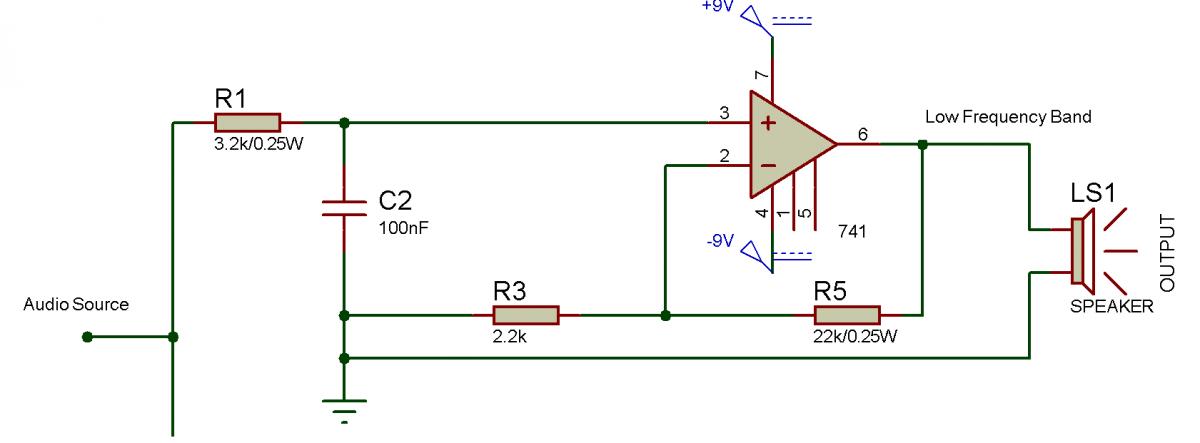
A circuit diagram of a 741 operational amplifier used with an active low-pass filter.
In this low pass filter circuit, IC LM741 is used as non-inverting amplifier. T The filter input signal is connected to the non-inverting input pin of the IC (pin 3). A 22 kilo-ohm resistor (“R6” in the circuit diagram) is connected between pins 6 and 2 of the IC, providing negative feedback. The inverting pin (pin 2) is grounded through a 2.2 kilo-ohm resistor (“R4”) .
The amplifier gain is defined by these resistors and can be calculated as follows:
Gain = (R6/R4)
= 22/2.2 kilo ohms
= 10
The low frequency element of the audio signal is amplified 10 times compared to the input audio signal. The output of the op amp is taken from pin 6 of the IC, which is connected to one of the speaker wires.
speakers – Two speakers are used in the circuit, with a power of 25 mW and 8 ohms of impedance. One wire from each speaker is connected to the op amp output pins and the other is connected to common ground.
The speakers regenerate the sound of the audio signal. Ideally, high-frequency signals should be sent to a tweeter and low-frequency signals to a woofer. For this tutorial, however, basic speakers are used in the circuit.
Safety first
The following precautions must be taken when assembling this circuit:
1. Use only speakers equivalent to the amplifier output – or of high power.
2. Avoid clipping the output signal as this may damage the speakers.
3. Always place components as close together as possible to reduce noise in the circuit.
4. The breadboard produces a lot of noise and loose components, so it is recommended to make this circuit on PCB for clarity without distortion and noise.
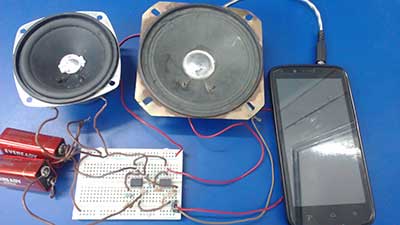
A two-way audio crossover prototype.
How the circuit works
A single audio channel is fed as input to the circuit, and the high-pass and low-pass filter circuits receive this audio signal. The high-pass filter extracts the high-frequency audio signals (frequencies above 500 Hz) and sends them to the operational amplifier, which amplifies the signal by 10.
Similarly, the low-pass filter extracts the low-frequency signals (frequencies below 500 Hz) and sends them to the operational amplifier, which amplifies the signal by 10. The output of the high-pass and low-pass filters is directed to different speakers. Since the low and high frequency elements of the audio signal are separated and sent to the ideal speakers, the amplified sound is crisp and clear.
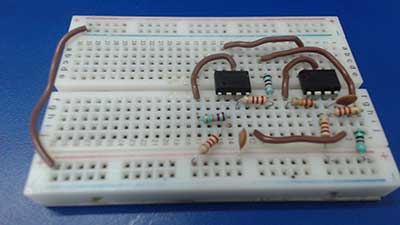
A pottype of an active, high-pass and low-pass filter.
Testing the circuit
To test the filter circuit, a function generator is used as the input source to generate a sine wave of constant amplitude and variable frequency. Because an audio signal is essentially a sine wave, a function generator can be used instead of a microphone or other type of audio source.
You will notice that headphones are not used during testing as their speakers are resistive and inductive. At different frequencies, this is inductance changes, which in turn changes the impedance (R and L combination) of the speaker.
Therefore, using a speaker as a load to derive its specifications at the op amp output may lead to false or nonstandard results. Instead, a purely resistive dummy load is used. Since the resistance does not change with frequency, it can be considered a reliable load regardless of the input frequency of the audio signal.
The peak-to-peak amplitude of the function generator signal is set to 23 mV and a 100 ohm resistive load is connected to the output (instead of the speakers). The cutoff frequency of the high-pass and low-pass filters should be 500 Hz and the voltage gain of the op-amp should be 10.
In this case, a voltage gain of 11 was observed. The frequency response of the high-pass and low-pass filters was as follows:
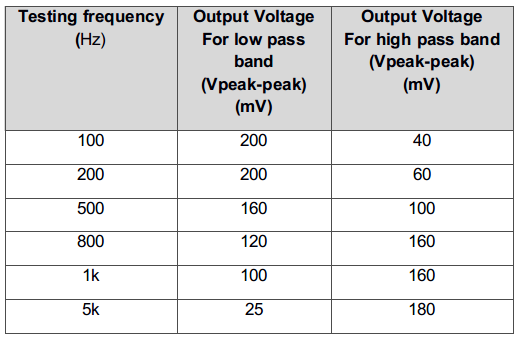
The output results from a two-way audio crossover.
This table is then used to plot a frequency curve for the high-pass and low-pass filters.
The frequency curve of the low-pass filter:
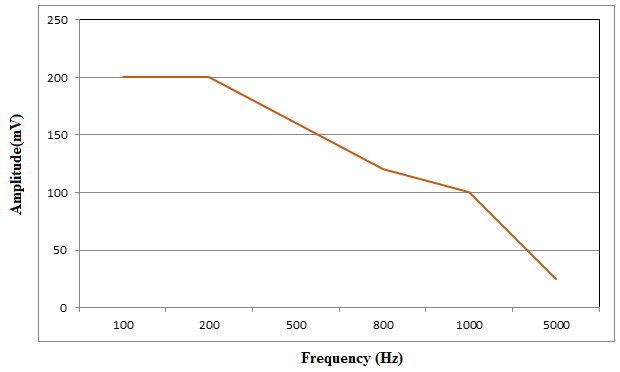
The frequency response of the low-pass filter.
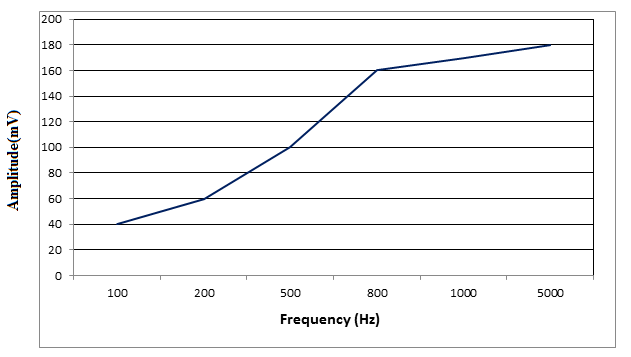
The frequency response of the high-pass filter.
The frequency curve for the high-pass and low-pass filters can be plotted more accurately by taking a voltage level reading for a greater number of frequencies.
In summary, we designed a bidirectional crossover in this tutorial, which has a maximum output power of 22 mW and a signal gain of 20 dB. That is, the cutoff frequency is 500 Hz. The crossover for other cutoff frequencies can also be designed by selecting suitable resistor and capacitor values for the high-pass and low-pass filter circuits.
This audio crossover can be used to drive different types of speakers such as tweeters, woofers, and subwoofers . It can also be used in Hi-Fi audio systems to separate the frequency band of the audio signal .
This was a simple circuit design using few components, but it can be converted into a three-way (or more) crossover by adding more filters into the circuit.
In the next tutorial, we will design an audio equalizer.

